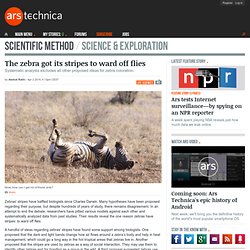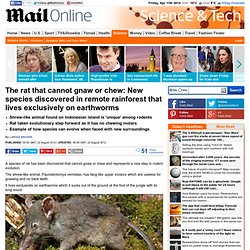

The zebra got its stripes to ward off flies. Zebras' stripes have baffled biologists since Charles Darwin.

Many hypotheses have been proposed regarding their purpose, but despite hundreds of years of study, there remains disagreement. In an attempt to end the debate, researchers have pitted various models against each other and systematically analyzed data from past studies. Their results reveal the one reason zebras have stripes: to ward off flies. A handful of ideas regarding zebras’ stripes have found some support among biologists.
One proposed that the dark and light bands change how air flows around a zebra’s body and help in heat management, which could go a long way in the hot tropical areas that zebras live in. All these ideas were shot down when tested rigorously. The first was that the stripes are used to dodge predators. Martin Stevens at the University of Exeter has researched the motion dazzle hypothesis by getting human subjects to catch moving striped objects on a computer. Evolution Is Predictable Shown by Lizards. July 19, 2013 Image Caption: This image shows pairs of Anolis species from different Greater Antillean islands that have independently evolved matching morphologies.

Anoles diversifying on four islands repeatedly colonized the same adaptive peaks on a shared evolutionary landscape, resulting not just in convergence among a few species pairs, such as those shown here, but in the convergence of entire island anole faunas. From left to right, the top row depicts giant tree crown specialists Anolis cuvieri (Puerto Rico; photo by J. Losos) and A. garmani (Jamaica); second row depicts the twig specialists A. garridoi (Cuba) and A. occultus (Puerto Rico); third row depicts trunk and ground specialists A. cybotes (Hispaniola; photo by B. Falk) and A. lineatopus (Jamaica); fourth row depicts grass specialists A. alumina (Hispaniola; photo by M. University of California – Davis If you could hit the reset button on evolution and start over, would essentially the same species appear? Swallows have 'evolved' shorter wing to dodge traffic in just 30 YEARS.
Birds' wings have reduced in length by as much as four millimetres over the past 30 yearsNatural selection has favoured birds that are better able to get out of the way of oncoming cars and trucks By Daily Mail Reporter Published: 16:04 GMT, 18 March 2013 | Updated: 03:50 GMT, 19 March 2013.

New rat species discovered in remote rainforest lives exclusively on earthworms. Shrew-like animal found on Indonesian island is 'unique' among rodentsRat taken evolutionary step forward as it has no chewing molarsExample of how species can evolve when faced with new surroundings By Larisa Brown Published: 00:52 GMT, 22 August 2012 | Updated: 06:58 GMT, 22 August 2012.

Human Evolution Still Tied to Darwinian Selection. A Finish family featured in the research.

As it turns out, even with all our medical technology and health education, we can’t outrun the findings of Charles Darwin. A study conducted by an international collaboration of scientists shows that humans are continuing to evolve just like other species in the wild. New evidence proves humans are continuing to evolve and that significant natural and sexual selection is still taking place in our species in the modern world. Despite advancements in medicine and technology, as well as an increased prevalence of monogamy, research reveals humans are continuing to evolve just like other species. Scientists in an international collaboration, which includes the University of Sheffield, analyzed church records of about 6,000 Finnish people born between 1760-1849 to determine whether the demographic, cultural and technological changes of the agricultural revolution affected natural and sexual selection in our species.
Zoologger: Unique life form is half plant, half animal - life - 13 January 2012. Zoologger: My brain's so big it spills into my legs - life - 14 December 2011. Zoologger is our weekly column highlighting extraordinary animals – and occasionally other organisms – from around the world Species: Anapisona simoniHabitat: damp litter in the forests of Central America, weaving webs to feed its supersized brain Itsy bitsy spiders have a big problem: where to store their bulging brains.

For Anapisona simoni and other arachnid lightweights, the problem is so acute that their brains have literally spilled out of their body cavities and into their legs. Tiny creatures' brains and microelectronics have something in common, it turns out: ultimately, attempts to miniaturise the circuitry will hit a wall. Once the axons that transmit neural signals get down to 0.1 micrometre in diameter, for instance, channels that move ions across cell membranes get so "noisy" that signalling becomes unreliable. Microspider, monster brain. Living dinosaur found to be fastest evolving creature. How fast can a creature evolve?

While evolution has no ultimate direction, the DNA of some creatures are changing faster than others. As described in this month's edition of Trends in Genomics, a team of New Zealand researchers have found the fastest evolving vertebrate known to date: the Tuatara. The Tuatara, Sphendon punctatus, is essentially a living relic of the age of the dinosaurs, found only in New Zealand. It is the last living species in the order Sphenodontia. The creature's lineage split off during the Upper Triassic, about 220 million years ago—meaning that early tuataras lived along side the dinosaurs. According to researchers, the tuatara does everything slowly—it moves slowly, it metabolizes food slowly, it reproduces slowly—but it is changing at the molecular level at a rapid pace.